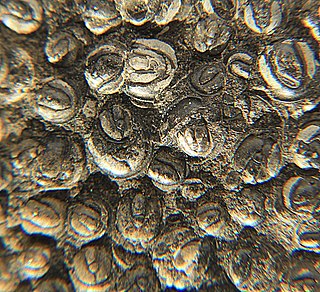
The Tremadocian is the lowest stage of Ordovician. Together with the later Floian Stage it forms the Lower Ordovician Epoch. The Tremadocian lasted from 485.4 to 477.7 million years ago. The base of the Tremadocian is defined as the first appearance of the conodont species Iapetognathus fluctivagus at the Global Boundary Stratotype Section and Point (GSSP) section on Newfoundland.
Paibi, a village in Paibi Township, Huayuan County, Xiangxi Tujia and Miao Autonomous Prefecture Hunan, China, is the location of the Global Boundary Stratotype Section and Point (GSSP) which marks the boundary between the third and Furongian epochs of the Cambrian Period on the geologic time scale. Paibi was selected over the Kyrshabakty River section, Malyi Karatau, Kazakhstan, and the GSSP was ratified by the International Union of Geological Sciences in late 2003. It established the first formally agreed upon subdivision of the Cambrian. The village gives its name to the Paibian Age in the Cambrian Period.
The Paibian is the lowest stage of Furongian series of the Cambrian. It follows the Guzhangian and is succeeded by the Jiangshanian Stage. The base is defined as the first appearance of the trilobite Glyptagnostus reticulatus around 497 million years ago. The top, or the base of the Jiangshanian is defined as the first appearance of the trilobite Agnostotes orientalis around 494 million years ago.

Agnostus is a genus of agnostid trilobites, belonging to the family Agnostidae, that lived during the late Middle Cambrian – early Upper Cambrian. It is the type genus of the family Agnostidae and is subdivided into two subgenera, Agnostus and Homagnostus.

Agraulos is a genus of Solenopleuridae trilobites that lived during the Middle Cambrian in North America and Europe, particularly the Czech Republic. The genus was named by Hawle & Corda in 1847.

Olenoides was a trilobite from the Cambrian period. Its fossils are found well-preserved in the Burgess Shale in Canada. It grew up to 10 cm long.

Cow Head is a town in the Canadian province of Newfoundland and Labrador. The town had a population of 478 in the Canada 2016 Census.

Peronopsis is a genus of trilobite restricted to the Middle Cambrian. Its remains have been found in Asia, Australia, Europe, and North America.

Salterella is an enigmatic Cambrian genus with a small, conical, calcareous shell that appears to be septate, but is rather filled with stratified laminar deposits. The shell contains grains of sediment, which are obtained selectively by a manner also observed in foramanifera. The genus was established by Elkanah Billings in 1861, and was named after the English palaeontologist John William Salter.
Acmarhachis is a genus of trilobite in the order Agnostida, which lived in what are now Australia, Canada, China (Anhui), Kazakhstan, Russia (Kharaulakh), and the US. It was described by Resser in 1938, and the type species is Acmarhachis typicalis.

Bathyuriscus is an extinct genus of Cambrian trilobite. It was a nektobenthic predatory carnivore. The genus Bathyuriscus is endemic to the shallow seas that surrounded Laurentia. Its major characteristics are a large forward-reaching glabella, pointed pleurae or pleurae with very short spines, and a medium pygidium with well-impressed furrows. Complete specimens have never reached the size of 7 cm predicted by the largest pygidium found. Bathyuriscus is often found with the free cheeks shed, indicating a moulted exoskeleton. An average specimen will in addition have a furrowed glabella, crescent-shaped eyes, be semi-circular in overall body shape, have 7 to 9 thoracic segments, and a length of about 1.5 inches.
Ivshinagnostus is a genus of trilobite in the order Agnostida, which existed in what is now Kazakhstan. It was described by Ergaliev in 1980, and the type species is Ivshinagnostus ivshini.
The Jiangshanian is the middle stage of the Furongian series. It follows the Paibian Stage and is succeeded by the still unnamed Stage 10 of the Cambrian. The base is defined as the first appearance of the trilobite Agnostotes orientalis which is estimated to be 494 million years ago. The Jiangshanian lasted until approximately 489.5 million years ago.

Pentagnostus is a genus of trilobites restricted to the Middle Cambrian. Its remains have been found in Siberia, Australia, North America, Scandinavia, and Kazakhstan.
Agnostotes orientalis is a species of agnostid trilobite belonging to the genus Agnostotes. It existed during the Jiangshanian Age of the Cambrian. It is an important index fossil in biostratigraphy.

Itagnostus is a genus of trilobite restricted to the Middle Cambrian. Its remains have been found in Asia, Australia, Europe, and North America.

Serrodiscus Richter and Richter 1941. is a genus of Eodiscinid trilobite belonging to the family Weymouthiidae Kobayashi T. (1943), Order Agnostida. It lived during the late Lower Cambrian, with remains found in Canada, China (Gansu), The United Kingdom (England), Germany (Silesia), Poland, the Russian Federation, and the United States. It is named for the spines on the ventral side of the pygidium, which give it a serrated impression.

Galeaspis is an extinct genus of ptychopariid trilobite in the family Catillicephalidae. Species are found in the Seletinian Horizon of the Kuyandinian faunal stage of Late Cambrian marine strata in Central Kazakhstan. Fossil specimens are usually semicircular to bean-shaped, incomplete cranidia, with globular glabella.
Calodiscus is a genus of Eodiscinid trilobite in the family Calodiscidae. It lived during the late Lower Cambrian, with remains found in Canada, the United States, Greenland, The United Kingdom (England), Sweden, France, Germany, Italy (Sardinia), Kazakhstan, the Russian Federation and China.

The Kyrshabakty is a river in southern Kazakhstan. It is a right tributary of the Shabakty, with a length of 95 km (59 mi) and a drainage basin of 805 km2 (311 sq mi).











